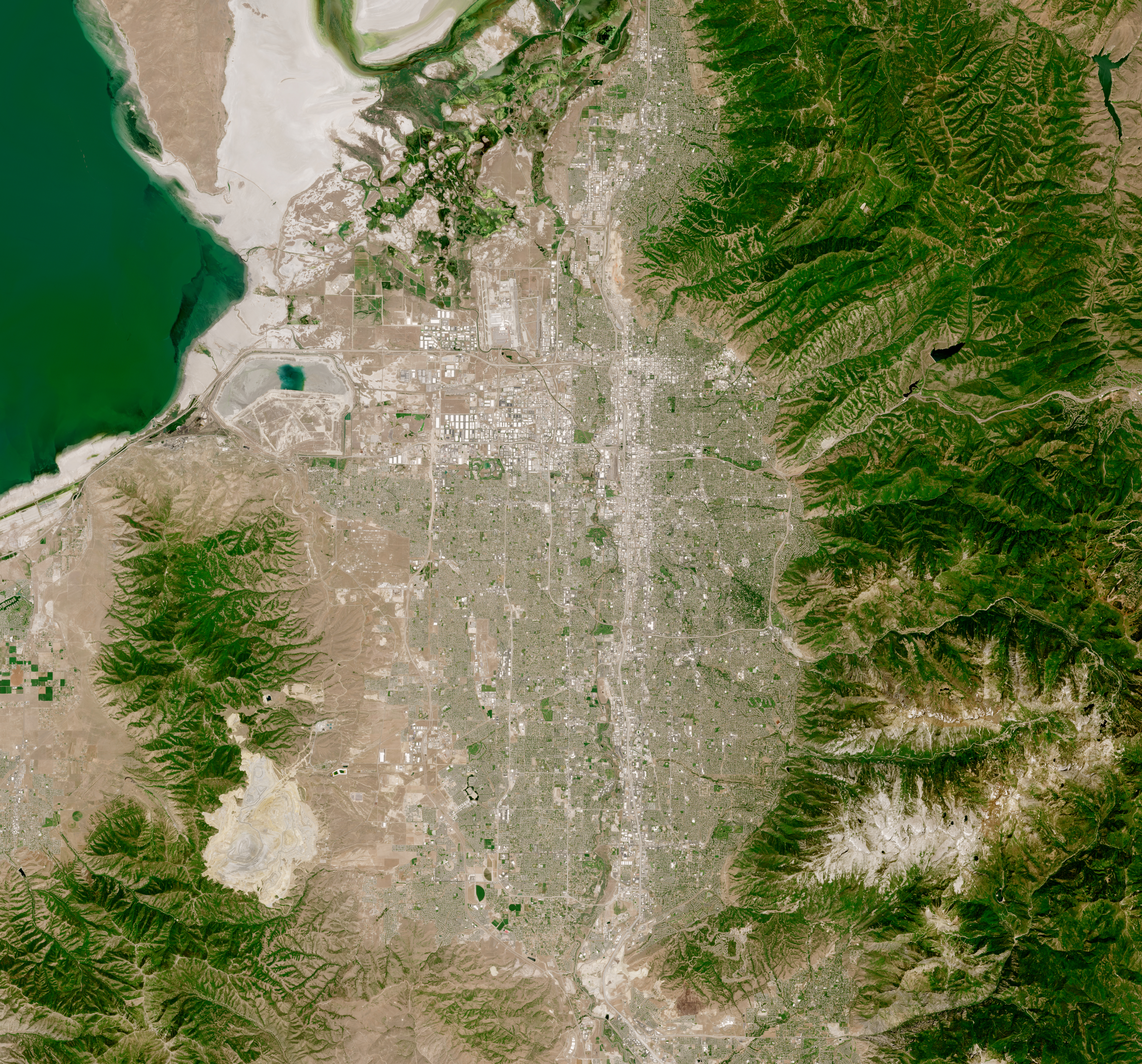Geography of Salt Lake City on:
[Wikipedia]
[Google]
[Amazon]


Salt Lake City
Salt Lake City (often shortened to Salt Lake and abbreviated as SLC) is the Capital (political), capital and List of cities and towns in Utah, most populous city of Utah, United States. It is the county seat, seat of Salt Lake County, Utah, Sal ...
is located in a large valley
A valley is an elongated low area often running between Hill, hills or Mountain, mountains, which will typically contain a river or stream running from one end to the other. Most valleys are formed by erosion of the land surface by rivers ...
, the Salt Lake Valley
Salt Lake Valley is a valley in Salt Lake County in the north-central portion of the U.S. state of Utah. It contains Salt Lake City and many of its suburbs, notably Murray, Sandy, South Jordan, West Jordan, and West Valley City; its total po ...
, separated by the eastern Wasatch Mountains
The Wasatch Range ( ) or Wasatch Mountains is a mountain range in the western United States that runs about from the Utah-Idaho border south to central Utah. It is the western edge of the greater Rocky Mountains, and the eastern edge of the G ...
, a subrange of the Rocky Mountains, and the Oquirrh Mountains
The Oquirrh Mountains is a mountain range that runs north-south for approximately 30 miles (50 km) to form the west side of Utah's Salt Lake Valley, separating it from Tooele Valley. The range runs from northwestern Utah County–centr ...
to the west.
Salt Lake City is located at 40°45'17" North, 111°53'33" West (40.754700, -111.892622).
According to the United States Census Bureau
The United States Census Bureau (USCB), officially the Bureau of the Census, is a principal agency of the U.S. Federal Statistical System, responsible for producing data about the American people and economy. The Census Bureau is part of the ...
, the city has a total area of 285.9 km² (110.4 mi²). 282.5 km² (109.1 mi²) of it is land and 3.3 km² (1.3 mi²) of it is water. The total area is 1.17% water.
Like most of the cities stretching north and south of Salt Lake City (see Ogden and Provo), it lies at the base of the Wasatch Mountains, which in some places rise impressively 6,000 feet (1,850 m) above the valley floor. This metro area is known commonly as the Wasatch Front
The Wasatch Front is a metropolitan region in the north-central part of the U.S. state of Utah. It consists of a chain of contiguous cities and towns stretched along the Wasatch Range from approximately Provo in the south to Logan in the north ...
. Most of the valley floor is built up, except for some rapidly disappearing fields and farms on the south and west sides of the valley. Some parts of the benches have residential construction.
The valley floor is the lake bed of the ancient Lake Bonneville
Lake Bonneville was the largest Late Pleistocene paleolake in the Great Basin of western North America. It was a pluvial lake that formed in response to an increase in precipitation and a decrease in evaporation as a result of cooler temperature ...
, of which the Great Salt Lake is a remnant. Soils in the valley are largely clay
Clay is a type of fine-grained natural soil material containing clay minerals (hydrous aluminium phyllosilicates, e.g. kaolin, Al2 Si2 O5( OH)4).
Clays develop plasticity when wet, due to a molecular film of water surrounding the clay par ...
and sand
Sand is a granular material composed of finely divided mineral particles. Sand has various compositions but is defined by its grain size. Sand grains are smaller than gravel and coarser than silt. Sand can also refer to a textural class of s ...
, which exposes the city's edifices to considerable risk of damage due to liquefaction
In materials science, liquefaction is a process that generates a liquid from a solid or a gas or that generates a non-liquid phase which behaves in accordance with fluid dynamics.
It occurs both naturally and artificially. As an example of the ...
caused by an earthquake
An earthquake (also known as a quake, tremor or temblor) is the shaking of the surface of the Earth resulting from a sudden release of energy in the Earth's lithosphere that creates seismic waves. Earthquakes can range in intensity, from ...
. The Wasatch Fault
The Wasatch Fault is an active fault located primarily on the western edge of the Wasatch Mountains in the U.S. states of Utah and Idaho. The fault is about long, stretching from southern Idaho, through northern Utah, before terminating in cen ...
runs along the eastern benches of the city, and geologists consider it due for a major earthquake. On February 21, 2008 a 6.2M earthquake hit Eastern Nevada 42 miles west of Wendover, Utah and could be felt in northern Utah, including Salt Lake City (200+ miles away).
The marshlands and mudflats to the south and east of the Great Salt Lake border the city's northwest side. Freshwater estuaries enter the lake here, and the lower salinity combines with the marshy terrain to result in considerable algae growth. Under certain weather conditions, which occur up to roughly a dozen times a year, some of the algae dies off and decays, and the northwest winds carry the scent of decaying algae into the city. The smell is known as "lake stink".
References
{{coord, 40, 45, 17, N, 111, 53, 33, W, source:enwiki-plaintext-parser, display=title